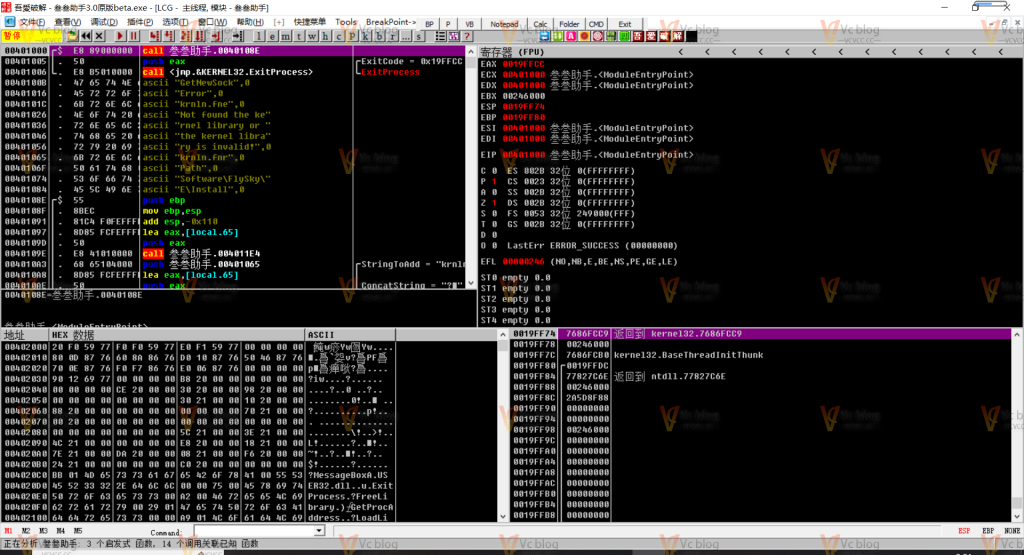【摘要】
【摘要】
在当今高阶语言盛行的时代,C语言依然在操作系统、嵌入式系统和性能敏感应用中占据统治地位。本文基于C17/C23标准,深入剖析指针、内存管理和现代调试技术的核心原理,提供从基础概念到高级优化的完整解决方案,包含真实场景案例和可立即执行的代码示例,帮助开发者彻底掌握C语言的内存艺术。
![图片[1]-C语言内存管理深度解析:从指针陷阱到现代调试技术的完全指南-Vc博客](https://blogimg.vcvcc.cc/2025/10/f613c00659e74440aae6f0364b3faa20preview.jpegtplv-a9rns2rl98-downsize_watermark_1_61.jpg?imageView2/0/format/webp/q/75)
一、C语言内存模型深度解析
1. 现代内存架构演进
根据2024年TIOBE编程语言排行榜,C语言依然稳居前两名,在系统编程和嵌入式领域占有不可替代的地位。最新C23标准在内存模型方面做出重要改进:
内存区域划分:
- 代码区:存放函数体的二进制代码,只读属性
- 全局区:存放全局变量和静态变量,程序结束时释放
- 栈区:编译器自动分配释放,存放函数参数和局部变量
- 堆区:程序员手动分配释放,生存期由程序员控制
2. 指针本质与内存地址
#include <stdio.h>
#include <stdint.h>
void pointer_analysis() {
int arr[5] = {10, 20, 30, 40, 50};
int *ptr = arr;
printf("数组地址分析:\n");
printf("arr[0] 地址: %p, 值: %d\n", (void*)&arr[0], arr[0]);
printf("ptr 地址: %p, 指向: %p, 值: %d\n",
(void*)&ptr, (void*)ptr, *ptr);
// 指针算术运算
printf("\n指针算术:\n");
for(int i = 0; i < 5; i++) {
printf("ptr + %d = %p, *(ptr + %d) = %d\n",
i, (void*)(ptr + i), i, *(ptr + i));
}
}二、动态内存管理完全指南
1. 堆内存分配核心函数
#include <stdio.h>
#include <stdlib.h>
#include <string.h>
#define ARRAY_SIZE 10
struct student {
int id;
char name[50];
float score;
};
void dynamic_memory_demo() {
// 1. malloc - 基本内存分配
int *int_array = (int*)malloc(ARRAY_SIZE * sizeof(int));
if(int_array == NULL) {
fprintf(stderr, "内存分配失败\n");
return;
}
// 初始化分配的内存
for(int i = 0; i < ARRAY_SIZE; i++) {
int_array[i] = i * 10;
}
// 2. calloc - 带初始化的分配
struct student *students = (struct student*)calloc(5, sizeof(struct student));
if(students) {
for(int i = 0; i < 5; i++) {
students[i].id = i + 1;
snprintf(students[i].name, 50, "学生%d", i + 1);
students[i].score = 85.5 + i;
}
}
// 3. realloc - 内存重新分配
int_array = (int*)realloc(int_array, ARRAY_SIZE * 2 * sizeof(int));
if(int_array) {
for(int i = ARRAY_SIZE; i < ARRAY_SIZE * 2; i++) {
int_array[i] = i * 10;
}
}
// 必须释放内存
free(int_array);
free(students);
int_array = NULL; // 避免悬空指针
students = NULL;
}2. 内存管理最佳实践
#include <stdio.h>
#include <stdlib.h>
#include <assert.h>
// 安全的内存分配宏
#define SAFE_MALLOC(ptr, type, count) \
do { \
ptr = (type*)malloc((count) * sizeof(type)); \
if (!ptr) { \
fprintf(stderr, "内存分配失败: %s:%d\n", __FILE__, __LINE__); \
exit(EXIT_FAILURE); \
} \
} while(0)
#define SAFE_FREE(ptr) \
do { \
if (ptr) { \
free(ptr); \
ptr = NULL; \
} \
} while(0)
void safe_memory_management() {
int *data = NULL;
// 安全分配
SAFE_MALLOC(data, int, 100);
// 使用内存
for(int i = 0; i < 100; i++) {
data[i] = i * i;
}
// 安全释放
SAFE_FREE(data);
// 验证指针已置空
assert(data == NULL);
}三、常见内存问题与调试技术
1. 内存泄漏检测
#include <stdio.h>
#include <stdlib.h>
#ifdef DEBUG_MEMORY
static size_t total_allocated = 0;
void* debug_malloc(size_t size) {
void *ptr = malloc(size);
if(ptr) {
total_allocated += size;
printf("分配: %zu 字节, 总分配: %zu 字节\n", size, total_allocated);
}
return ptr;
}
void debug_free(void *ptr, size_t size) {
if(ptr) {
free(ptr);
total_allocated -= size;
printf("释放: %zu 字节, 剩余: %zu 字节\n", size, total_allocated);
}
}
#define malloc(size) debug_malloc(size)
#define free(ptr) debug_free(ptr, size)
#endif
void memory_leak_demo() {
int *leaky_data = (int*)malloc(1000 * sizeof(int));
// 忘记释放 - 内存泄漏!
// free(leaky_data);
}2. 现代调试工具实战
#include <stdio.h>
#include <stdlib.h>
#include <string.h>
// AddressSanitizer 检测示例
void address_sanitizer_demo() {
// 堆缓冲区溢出
char *buffer = (char*)malloc(10);
strcpy(buffer, "这个字符串太长会导致溢出");
free(buffer);
// 使用已释放内存
int *data = (int*)malloc(sizeof(int));
free(data);
*data = 42; // 使用已释放内存
// 栈缓冲区溢出
char stack_buffer[5];
strcpy(stack_buffer, "溢出");
}四、高级内存优化技术
1. 内存池实现
#include <stdio.h>
#include <stdlib.h>
#include <string.h>
#define POOL_SIZE 1024 * 1024 // 1MB
typedef struct memory_pool {
char *buffer;
size_t size;
size_t used;
} memory_pool;
memory_pool* pool_create(size_t size) {
memory_pool *pool = (memory_pool*)malloc(sizeof(memory_pool));
if(!pool) return NULL;
pool->buffer = (char*)malloc(size);
if(!pool->buffer) {
free(pool);
return NULL;
}
pool->size = size;
pool->used = 0;
return pool;
}
void* pool_alloc(memory_pool *pool, size_t size) {
if(pool->used + size > pool->size) {
return NULL; // 内存池耗尽
}
void *ptr = pool->buffer + pool->used;
pool->used += size;
return ptr;
}
void pool_destroy(memory_pool *pool) {
if(pool) {
free(pool->buffer);
free(pool);
}
}2. 对齐内存分配
#include <stdlib.h>
#include <string.h>
void* aligned_malloc(size_t size, size_t alignment) {
void *ptr = NULL;
// 分配额外空间用于存储原始指针和对齐
size_t total_size = size + alignment + sizeof(void*);
void *original_ptr = malloc(total_size);
if(original_ptr) {
// 计算对齐的内存地址
ptr = (void*)(((size_t)original_ptr + sizeof(void*) + alignment - 1) & ~(alignment - 1));
// 在对齐的内存前面存储原始指针
*((void**)((char*)ptr - sizeof(void*))) = original_ptr;
}
return ptr;
}
void aligned_free(void *ptr) {
if(ptr) {
// 获取原始指针并释放
void *original_ptr = *((void**)((char*)ptr - sizeof(void*)));
free(original_ptr);
}
}五、真实项目案例:自定义字符串库
1. 安全字符串实现
#include <stdio.h>
#include <stdlib.h>
#include <string.h>
#include <stdbool.h>
typedef struct {
char *data;
size_t length;
size_t capacity;
} string_t;
string_t* string_create(const char *initial) {
string_t *str = (string_t*)malloc(sizeof(string_t));
if(!str) return NULL;
size_t len = initial ? strlen(initial) : 0;
str->capacity = len + 1;
str->data = (char*)malloc(str->capacity);
if(!str->data) {
free(str);
return NULL;
}
if(initial) {
strncpy(str->data, initial, len);
}
str->data[len] = '#include <stdio.h>
#include <stdlib.h>
#include <string.h>
#include <stdbool.h>
typedef struct {
char *data;
size_t length;
size_t capacity;
} string_t;
string_t* string_create(const char *initial) {
string_t *str = (string_t*)malloc(sizeof(string_t));
if(!str) return NULL;
size_t len = initial ? strlen(initial) : 0;
str->capacity = len + 1;
str->data = (char*)malloc(str->capacity);
if(!str->data) {
free(str);
return NULL;
}
if(initial) {
strncpy(str->data, initial, len);
}
str->data[len] = '\0';
str->length = len;
return str;
}
bool string_append(string_t *str, const char *append) {
if(!str || !append) return false;
size_t append_len = strlen(append);
size_t new_len = str->length + append_len;
if(new_len + 1 > str->capacity) {
// 需要重新分配
size_t new_capacity = new_len * 2 + 1;
char *new_data = (char*)realloc(str->data, new_capacity);
if(!new_data) return false;
str->data = new_data;
str->capacity = new_capacity;
}
strncpy(str->data + str->length, append, append_len);
str->length = new_len;
str->data[new_len] = '\0';
return true;
}
void string_destroy(string_t *str) {
if(str) {
free(str->data);
free(str);
}
}
';
str->length = len;
return str;
}
bool string_append(string_t *str, const char *append) {
if(!str || !append) return false;
size_t append_len = strlen(append);
size_t new_len = str->length + append_len;
if(new_len + 1 > str->capacity) {
// 需要重新分配
size_t new_capacity = new_len * 2 + 1;
char *new_data = (char*)realloc(str->data, new_capacity);
if(!new_data) return false;
str->data = new_data;
str->capacity = new_capacity;
}
strncpy(str->data + str->length, append, append_len);
str->length = new_len;
str->data[new_len] = '#include <stdio.h>
#include <stdlib.h>
#include <string.h>
#include <stdbool.h>
typedef struct {
char *data;
size_t length;
size_t capacity;
} string_t;
string_t* string_create(const char *initial) {
string_t *str = (string_t*)malloc(sizeof(string_t));
if(!str) return NULL;
size_t len = initial ? strlen(initial) : 0;
str->capacity = len + 1;
str->data = (char*)malloc(str->capacity);
if(!str->data) {
free(str);
return NULL;
}
if(initial) {
strncpy(str->data, initial, len);
}
str->data[len] = '\0';
str->length = len;
return str;
}
bool string_append(string_t *str, const char *append) {
if(!str || !append) return false;
size_t append_len = strlen(append);
size_t new_len = str->length + append_len;
if(new_len + 1 > str->capacity) {
// 需要重新分配
size_t new_capacity = new_len * 2 + 1;
char *new_data = (char*)realloc(str->data, new_capacity);
if(!new_data) return false;
str->data = new_data;
str->capacity = new_capacity;
}
strncpy(str->data + str->length, append, append_len);
str->length = new_len;
str->data[new_len] = '\0';
return true;
}
void string_destroy(string_t *str) {
if(str) {
free(str->data);
free(str);
}
}
';
return true;
}
void string_destroy(string_t *str) {
if(str) {
free(str->data);
free(str);
}
}六、跨平台内存管理考虑
1. 平台差异处理
#include <stdio.h>
#include <stdlib.h>
// 平台特定的内存对齐
#ifdef _WIN32
#include <malloc.h>
#define ALIGNED_ALLOC(alignment, size) _aligned_malloc(size, alignment)
#define ALIGNED_FREE(ptr) _aligned_free(ptr)
#else
#define ALIGNED_ALLOC(alignment, size) aligned_alloc(alignment, size)
#define ALIGNED_FREE(ptr) free(ptr)
#endif
void cross_platform_memory() {
// 跨平台对齐内存分配
void *aligned_mem = ALIGNED_ALLOC(16, 1024);
if(aligned_mem) {
printf("对齐内存分配成功: %p\n", aligned_mem);
ALIGNED_FREE(aligned_mem);
}
}七、现代C语言内存调试工作流
1. 集成调试技术
#include <stdio.h>
#include <stdlib.h>
// 编译时添加: -fsanitize=address -g
void modern_debugging_workflow() {
// 1. 使用AddressSanitizer
int *array = (int*)malloc(10 * sizeof(int));
array[10] = 42; // 越界写入 - ASan会捕获
// 2. 使用Valgrind检测
int *leak = (int*)malloc(100);
// 故意不释放来检测内存泄漏
free(array);
}【总结】
C语言内存管理是系统编程的核心技能,从基础的指针操作到高级的内存池优化,每一个细节都直接影响程序的性能和稳定性。通过掌握动态内存分配、内存调试工具和安全编程实践,开发者可以构建出既高效又可靠的C语言应用程序。现代C语言标准的发展为内存安全提供了更多工具和技术,结合AddressSanitizer、Valgrind等现代调试工具,可以大幅提升开发效率和代码质量。
© 版权声明
THE END

















暂无评论内容